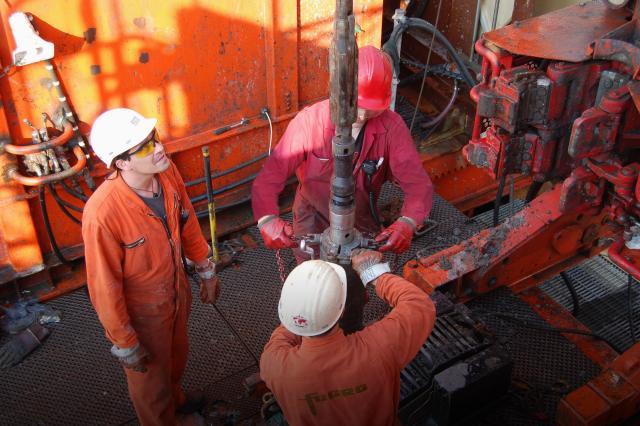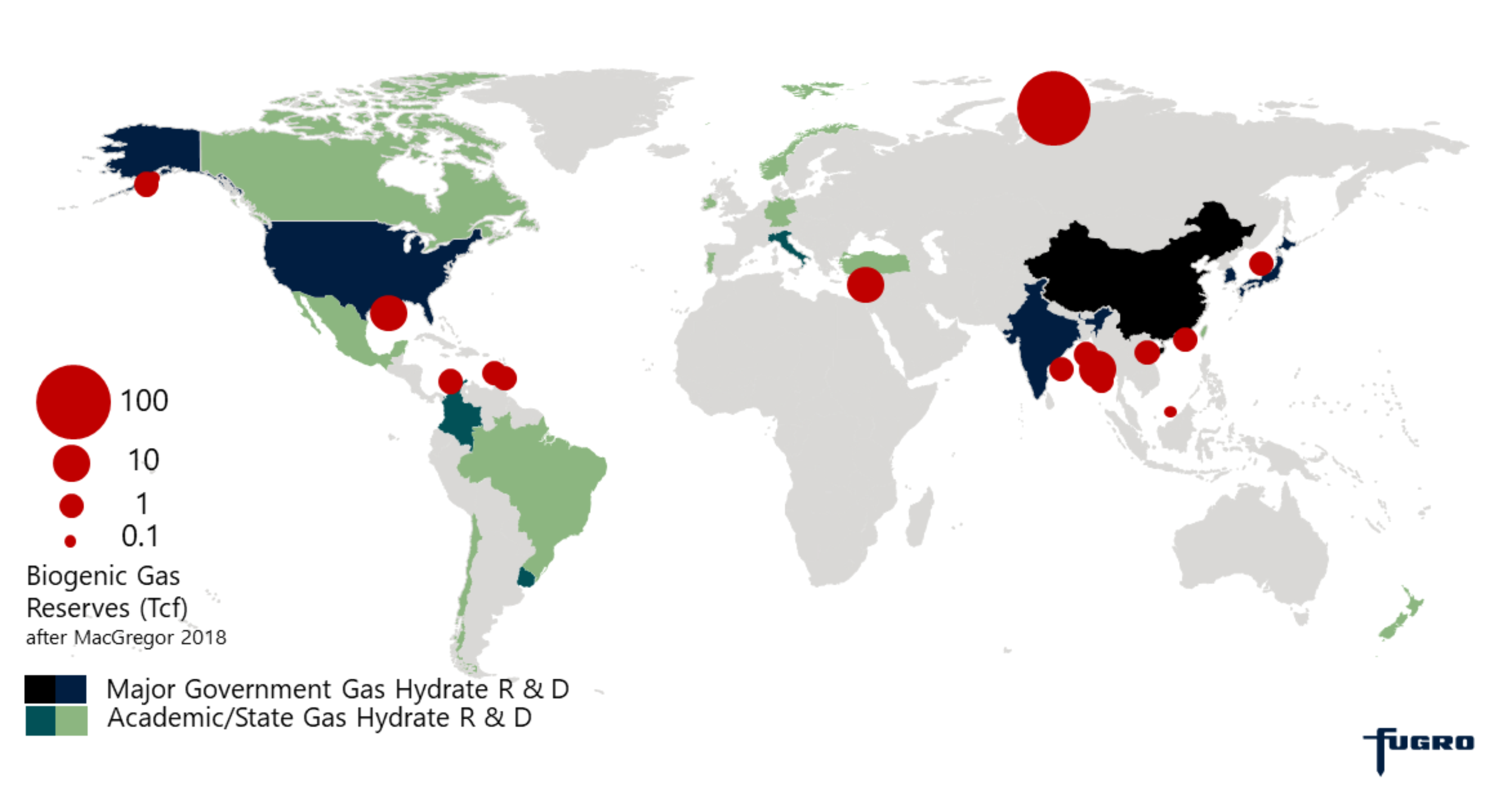
Engineers on Fugro’s REM Etive take pressure cores of buried gas hydrate deposits for reservoir saturation confirmation. (Source: Fugro)
[Editor's note: This story appears in the June 2020 edition of E&P. Subscribe to the magazine here. It was originally published June 1, 2020.]
Even though the natural gas market is not currently affected by supply insecurity, research into natural gas hydrates as a potential resource is still active. Methane hydrate resource potential is immense, and the world’s press took notice of the successful short-term marine gas hydrate production tests in 2017 off the east coast of Japan and in the South China Sea. What has international methane hydrate research achieved so far? What is the relationship between gas hydrate and large conventional biogenic gas deposits? And what is the time line for developing methane hydrate as a natural gas resource?
What is methane hydrate?
Gas hydrates are a solid form of light hydrocarbon gases and water. Methane hydrate is a dense energy source of natural gas and therefore sometimes referred to as “nature’s LNG.” Gas hydrates, which resemble ice, are part of the natural hydrocarbon migration system and an integral component of the Arctic petroleum system, where it is cold enough for gas hydrates to form. They are also widespread in deep water on continental margins, where pressures are high enough for gas hydrates to form. Gas hydrates are not always useful: a robust billion-dollar business controls gas hydrate formation in deepwater pipelines and subsea production facilities because they can restrict and plug the flow of hydrocarbons.
International research
Serious research to develop natural gas hydrates as a resource started in Japan in the early 2000s, followed by India and Korea. At the same time, the U.S. began a multiagency research effort led by its Department of Energy (DOE), and China has fielded six major field programs in the last 14 years to confirm gas hydrate deposits in the South China Sea. Advances to date include reservoir characterization, including confirmation of direct detection of high-saturation gas hydrates in offshore sand deposits, production technologies and reservoir production simulators. The consensus so far is that conventional oil and gas production equipment and technologies can be modified to produce gas hydrates. Gas hydrates, unlike conventional hydrocarbons, will not flow freely between the reservoir and wellhead by pressure differences. Changing the gas hydrate into gas and water requires active depressurization through pumping, as demonstrated in the short-term Arctic and marine production tests. Thermal and chemical means to dissociate gas hydrate are only likely to be employed for flow assurance and production system control.
Biogenic gas plays
The elements of a petroleum system (source rock, expulsion and migration to reservoir) are the fundamental concepts of oil and gas exploration. If gas hydrates are mentioned in the oil and gas exploration context, they are often described as possible indicators of secondary and tertiary migration from the object of exploration (deep thermogenic hydrocarbon reservoirs). So far, gas hydrate field expeditions have confirmed thermogenic gas hydrate, but these are best described as having mixed thermogenic and biogenic isotopic signatures. Most gas hydrates, however, are associated not with thermogenic gas migration, which is a by-product of thermal cracking of kerogen within much older sedimentary rocks, but with biogenic gas systems, in which methane is a by-product of the bacterial activity involved in CO2 reduction in very young sediments during their burial.
In parallel, biogenic gas plays are getting a new look, and these will have possible economic gas hydrate deposits associated with them. In fact, gas hydrates might have helped form them. Economic biogenic gas accumulations and the associated gas hydrate deposits are young systems that may form in less than 100,000 years. In the last 20 years, deepwater conventional biogenic gas discoveries with about 100 Tcf of gas reserves have been developed. Large economic conventional biogenic gas systems are also highly likely to be associated with high-saturation gas hydrate deposits.
Gas hydrates are intimately related to the processes of how biogenic gas basins generate and preserve economic quantities of natural gas. The window for biogenic gas generation is in the compaction and dewatering phase of the sediments within the upper 2 km of burial. After oxygen and sulfates are depleted during initial burial, the controlling parameters for biogenic gas production are temperature, organic matter and space. In biogenic gas systems, methanogenic bacteria feed on labile organic matter in the pore space until the sediments compact too much or it becomes too hot for the bacteria to be there.
Gas hydrate link to biogenic gas preservation?
Large deepwater biogenic gas plays have three essential components: rapid sedimentation of organic rich sediments, cool geothermal gradients and early trap formation. This scenario preserves the ability of methanogenic bacteria to produce methane while the sediment column is compacting to create an imperfect but sufficient seal.
Gas hydrates also may help concentrate conventional biogenic gas deposits.
Recent gas hydrate field programs in India support the growing hypothesis that large gas hydrate deposits need an immediate local overlying lithologic seal.

Large gas hydrate deposits in India’s Krishna Godavari Basin were direct-detected from seismic response, and pressure cores confirmed there was a tight lithologic seal directly over the gas-hydrate-filled sand. In contrast, the same sand in a step-out, also near the base of gas hydrate stability and subject to the same vertical methane migration, was not saturated with gas hydrate. The difference between the two locations was the absence of the sealing facies where the sand was water saturated.
The ability of gas hydrates to help concentrate and preserve biogenic gas is likely an important mechanism for the preservation of biogenic gas deposits. Escaping gassy fluids from the methane generation window can be available for capture within the gas hydrate stability field, but the overall migration will happen in the dissolved phase and would, without local seals, escape the system.
Hoteling of biogenic gas as gas hydrate as a mechanism for free gas concentration mechanism has been proposed for Camden Hills in Mississippi Canyon 348 in the Gulf of Mexico and at the multi-Tcf Shwe gas field offshore Myanmar. Recycling of gas hydrates at the base of gas hydrate stability due to rapid sedimentation and burial could be an important mechanism to understand large conventional biogenic gas resources and the associated gas hydrates above them. As these large biogenic gas plays become sanctioned for development, the exploration companies should consider setting targets for developing the secondary gas hydrate that remains and may be in reach.
Long-term gas hydrate production tests are key
Preparations for a long-term production test, a joint project of the U.S. DOE and the Japan Oil, Gas and Metals National Corp., are well underway on the Alaskan North Slope, where a stratigraphic and monitoring well was drilled in December 2018 in the Prudhoe Bay Unit along the Eileen gas hydrate trend.
This coming winter, the gas hydrate production wells at the site will be completed with the goal of demonstrating sustained long-term production of gas hydrates. The time line for international R&D to demonstrate safe, sustainable and economically feasible gas hydrate production is on the near horizon between five and 15 years.
Given the development time for the biogenic gas fields being developed by the industry, this will be just in time for oil and gas companies to add gas hydrate production to their Arctic and deepwater biogenic gas field production.
Recommended Reading
E&P Highlights: April 1, 2024
2024-04-01 - Here’s a roundup of the latest E&P headlines, including new contract awards.
Deepwater Roundup 2024: Offshore Australasia, Surrounding Areas
2024-04-09 - Projects in Australia and Asia are progressing in part two of Hart Energy's 2024 Deepwater Roundup. Deepwater projects in Vietnam and Australia look to yield high reserves, while a project offshore Malaysia looks to will be developed by an solar panel powered FPSO.
Petrobras to Step Up Exploration with $7.5B in Capex, CEO Says
2024-03-26 - Petrobras CEO Jean Paul Prates said the company is considering exploration opportunities from the Equatorial margin of South America to West Africa.
For Sale, Again: Oily Northern Midland’s HighPeak Energy
2024-03-08 - The E&P is looking to hitch a ride on heated, renewed Permian Basin M&A.
E&P Highlights: Feb. 26, 2024
2024-02-26 - Here’s a roundup of the latest E&P headlines, including interest in some projects changing hands and new contract awards.





